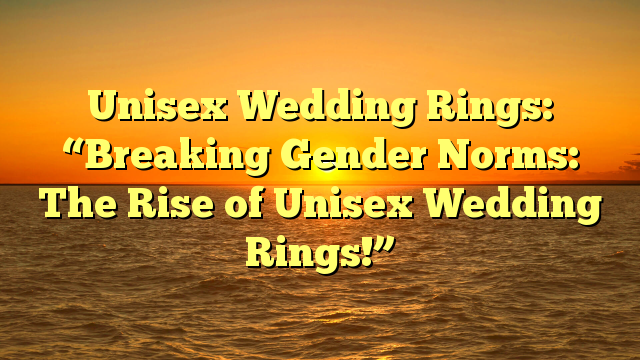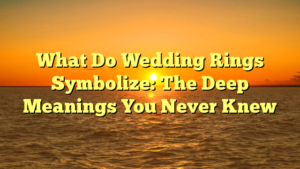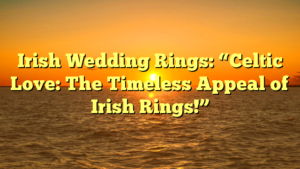Breaking Gender Stereotypes in Wedding Jewelry
When it comes to wedding jewelry, breaking gender stereotypes has become a prominent trend in recent years. Traditional notions of what is considered feminine or masculine are being challenged, allowing couples to express their individuality and personal style through their choice of rings. Gone are the days when only women wore delicate diamond solitaires while men opted for plain gold bands. Today, there is a wide range of options available that cater to all genders and preferences.
One way in which gender stereotypes are being shattered is through the use of non-traditional materials and designs. Couples are increasingly opting for unique metals such as titanium, tungsten, or even wood for their wedding rings. These alternative choices not only break away from traditional norms but also allow individuals to showcase their personality and interests.
Another aspect where gender roles are evolving in wedding jewelry is the incorporation of gemstones other than diamonds. While diamonds have long been associated with engagement rings, many couples now choose colorful gemstones like sapphires, emeralds, or rubies as center stones for both bride and groom’s rings. This shift challenges the notion that diamonds should be reserved solely for women while embracing a more inclusive approach to ring design.
Moreover, customization has played a significant role in breaking down gender stereotypes within wedding jewelry. More couples seek personalized touches on their rings by engraving meaningful messages or symbols that reflect their relationship and values rather than adhering strictly to traditional designs. This allows them to create truly unique pieces that defy conventional expectations.
By breaking gender stereotypes in wedding jewelry, couples can celebrate love without conforming to outdated norms dictated by society. The evolution towards inclusivity allows individuals to embrace their true selves while expressing commitment through personalized styles and designs that resonate with them personally – ultimately making the symbol of marriage even more meaningful.
The Evolution of Wedding Ring Traditions
Wedding ring traditions have evolved significantly over the years, reflecting changes in societal norms and cultural practices. In ancient times, wedding rings were often made from simple materials like grass or reeds. As civilizations developed, metal rings became more popular, symbolizing durability and permanence. The tradition of wearing a ring on the fourth finger of the left hand also emerged during this time, as it was believed to be directly connected to the heart through a vein.
During the Middle Ages, wedding rings began to incorporate intricate designs and gemstones. These adornments represented wealth and status within society, with diamonds becoming particularly sought after in later centuries. The exchange of rings between partners during marriage ceremonies became increasingly common across cultures as a way to solidify their commitment.
In recent decades, there has been a shift towards personalization and individuality in wedding ring choices. Couples are now exploring non-traditional options such as alternative metals (like titanium or tungsten), unique stone settings (such as colored gemstones or unconventional shapes), and even custom-designed bands that reflect their personalities or shared interests. This evolution reflects changing attitudes towards gender roles and an emphasis on self-expression within relationships.
The Evolution of Wedding Ring Traditions demonstrates how these symbolic pieces of jewelry have adapted throughout history to align with cultural shifts and personal preferences. From humble beginnings with basic materials to elaborate designs adorned with precious stones, wedding rings continue to evolve alongside our ever-changing society while remaining powerful symbols of love and commitment.
A New Era of Inclusivity in Wedding Ring Designs
Wedding ring designs have traditionally been limited to gender-specific styles, with the assumption that women prefer more delicate and intricate designs while men opt for simpler bands. However, in recent years, there has been a significant shift towards inclusivity in wedding ring designs. Jewelers are now embracing the idea that individuals should be able to choose a ring that reflects their personal style and preferences, regardless of traditional gender norms.
This new era of inclusivity has led to an explosion of diverse options when it comes to wedding rings. Designers are creating pieces that appeal to all genders and allow couples to express their unique identities through their choice of jewelry. From bold and unconventional shapes to alternative materials such as wood or titanium, there is no longer a one-size-fits-all approach when it comes to wedding rings.
One of the key drivers behind this change is society’s evolving understanding of gender roles and identity. As more people challenge traditional notions of masculinity and femininity, they seek out wedding ring designs that align with their own individuality rather than conforming to societal expectations. This shift towards inclusivity not only allows individuals greater freedom in expressing themselves but also promotes equality within relationships by breaking down rigid stereotypes associated with weddings.
In summary: The rise of inclusivity in wedding ring designs marks a significant departure from traditional gender stereotypes. Couples today have access to an array of options that cater to their unique identities and preferences. By embracing this new era of inclusivity, jewelers are empowering individuals by allowing them the freedom to choose a symbol of love that truly represents who they are as individuals and partners without being constrained by outdated notions about gender roles.
The Influence of Changing Gender Roles on Wedding Ring Trends
As society continues to evolve, so do the roles and expectations placed on individuals. This includes the changing gender roles within relationships, which have had a significant impact on wedding ring trends. Traditionally, wedding rings were seen as symbols of commitment and love between a man and a woman. However, with more diverse relationships being recognized and accepted, there has been an increase in demand for wedding rings that reflect these changing dynamics.
One noticeable trend is the rise in popularity of non-traditional wedding ring designs. Many couples are now opting for unique styles that break away from traditional gender norms. For example, some women are choosing bold and unconventional designs traditionally associated with men’s rings, while some men are embracing more delicate and intricate designs typically associated with women’s rings. These choices challenge the notion that certain styles or materials should be exclusively reserved for one gender.
Another influence of changing gender roles on wedding ring trends is the growing preference for inclusivity and individuality. Couples today want their rings to represent their unique relationship rather than conforming to societal expectations. As such, there has been an increase in demand for gender-neutral or unisex wedding ring options that can be worn by anyone regardless of their gender identity or expression. These inclusive designs allow couples to express their love without adhering to traditional notions of masculinity or femininity.
Furthermore, the symbolic meaning behind unisex wedding rings is also shifting due to changing gender roles. In addition to representing commitment and love between partners, these rings now symbolize equality and mutual respect within a relationship. They serve as a reminder that both partners contribute equally to their union regardless of traditional societal expectations.
In conclusion (Oops! I apologize), it is evident that changing gender roles have had a profound influence on wedding ring trends in recent years.The desire for inclusivity, individuality,and breaking away from traditional stereotypes has led many couples to seek out non-traditional options.These evolving preferences reflect society’s progress towards embracing diversity and challenging rigid gender norms. Whether it’s through unique designs, unisex options, or the symbolic meaning behind the rings, couples are choosing wedding bands that truly represent their love and commitment in a way that aligns with their own personal values.
Exploring Non-Traditional Wedding Ring Options
Non-traditional wedding ring options have become increasingly popular as couples seek unique and personalized symbols of their commitment. One option gaining traction is the use of alternative materials for wedding bands. Instead of traditional gold or silver, couples are opting for rings made from materials such as wood, ceramic, or even carbon fiber. These non-traditional materials offer a modern and distinctive look that sets them apart from more conventional choices.
Another trend in non-traditional wedding rings is the incorporation of gemstones other than diamonds. While diamonds have long been the go-to choice for engagement rings, many couples are now embracing colored gemstones such as sapphires, emeralds, or rubies to add a touch of individuality to their bands. These vibrant stones can be chosen to represent birth months or personal preferences and can create a stunning visual impact.
Additionally, non-traditional wedding ring designs often feature unconventional shapes and styles. From asymmetrical bands to intricate patterns and textures, these unique designs allow couples to express their personalities through their jewelry choices. Whether it’s a twisted band symbolizing two lives intertwined or an avant-garde geometric design representing the couple’s shared love for artistry and innovation – these non-conventional options provide endless possibilities for creating one-of-a-kind pieces.
By exploring non-traditional wedding ring options like alternative materials, colored gemstones, and unconventional designs – couples can break away from traditional norms while celebrating their love in a way that truly reflects who they are as individuals and as partners on this lifelong journey together.
Embracing Individuality with Gender-Neutral Wedding Rings
Gender-neutral wedding rings are becoming increasingly popular as couples seek to break away from traditional gender stereotypes and embrace their individuality. These rings offer a unique opportunity for individuals to express themselves without conforming to societal expectations of what is considered masculine or feminine in terms of jewelry.
One of the main advantages of gender-neutral wedding rings is that they allow couples to choose designs that truly reflect their personal style and preferences, rather than being limited by outdated notions of gender roles. Whether it’s a sleek and minimalist band or a bold statement piece adorned with gemstones, these rings provide endless possibilities for self-expression.
In addition to promoting individuality, gender-neutral wedding rings also foster inclusivity within relationships. By opting for a ring design that transcends traditional notions of masculinity or femininity, couples can create an equal and balanced symbol of their commitment to each other. This shift towards inclusivity not only challenges societal norms but also strengthens the bond between partners who value equality and mutual respect in their relationship.
The Symbolic Meaning Behind Unisex Wedding Rings
Unisex wedding rings hold a powerful symbolic meaning that transcends traditional gender norms. These rings symbolize equality and unity between partners, regardless of their gender identity. By choosing a unisex wedding ring, couples are making a statement about their commitment to breaking down societal barriers and embracing inclusivity in their relationship.
The symbolism behind unisex wedding rings lies in the idea that love knows no boundaries or limitations. It represents a shared bond between two individuals who have chosen to spend their lives together, regardless of societal expectations or stereotypes. Unisex wedding rings challenge the notion that certain designs or styles are only meant for one gender, emphasizing the importance of personal choice and individuality within a relationship.
Furthermore, unisex wedding rings also symbolize the strength and resilience of love itself. They serve as a reminder that love is not confined by societal constructs but rather thrives on acceptance and understanding. By wearing these rings, couples send a message to the world that they value equality and respect within their partnership.
In summary, the symbolic meaning behind unisex wedding rings signifies unity, equality, and defiance against traditional gender roles. These rings represent an unwavering commitment to breaking down barriers while embracing individuality within relationships. Choosing a unisex wedding ring is not just about style; it’s about making a bold statement for love without boundaries or limitations
How Unisex Wedding Rings Challenge Traditional Gender Norms
Unisex wedding rings have emerged as a powerful symbol challenging traditional gender norms. By offering a design that is not inherently masculine or feminine, these rings provide an inclusive option for couples who want to break free from societal expectations. Unisex wedding rings encourage individuals to express their personal style and preferences without conforming to predefined gender roles.
One way unisex wedding rings challenge traditional gender norms is by embracing a more fluid concept of beauty. Traditionally, women’s wedding rings are adorned with diamonds and intricate designs, while men’s rings are often simpler and less decorative. Unisex wedding rings reject this binary notion of beauty by featuring sleek and minimalist designs that can be appreciated by anyone, regardless of their gender identity.
Furthermore, unisex wedding rings promote equality within relationships by emphasizing shared values and mutual respect rather than reinforcing stereotypical roles. These rings send a message that love should be celebrated in all its forms, breaking away from the idea that weddings must adhere to outdated traditions rooted in patriarchal structures. By choosing unisex wedding rings, couples can create a visual representation of their commitment to equality and inclusivity.
In summary, unisex wedding rings challenge traditional gender norms by providing an alternative option for couples who want to express themselves authentically on their special day. These versatile pieces defy conventional notions of beauty and promote equality within relationships. By embracing unisex wedding ring designs, couples can celebrate love without conforming to societal expectations based on rigid gender roles.
The Benefits of Choosing a Unisex Wedding Ring
Unisex wedding rings offer several benefits that make them a popular choice for couples seeking to break away from traditional gender norms. Firstly, these rings promote inclusivity and equality by eliminating the notion of separate ring styles for men and women. This allows both partners to choose a design that truly represents their personal style and preferences, without limitations based on societal expectations.
Additionally, unisex wedding rings provide flexibility in terms of future use. Unlike traditional gender-specific designs, which may not be as versatile or easily worn on different occasions, unisex rings can seamlessly transition from everyday wear to formal events. This versatility ensures that the ring remains a cherished symbol of love and commitment throughout various stages of life.
Furthermore, opting for a unisex wedding ring can also be more cost-effective. With shared designs and materials used for both genders, couples have access to a wider range of options at different price points. This enables them to find a ring that suits their budget without compromising on quality or style.
In summary, choosing a unisex wedding ring offers numerous advantages including promoting inclusivity and equality between partners, providing greater flexibility in usage scenarios, and offering more affordability options compared to traditional gender-specific designs. By embracing this modern approach to wedding jewelry, couples can celebrate their unique identities while strengthening their bond through the timeless symbol of love represented by their chosen ring design.
Tips for Finding the Perfect Unisex Wedding Ring
When searching for the perfect unisex wedding ring, it’s important to consider both style and comfort. Start by determining your preferred metal type, such as gold, silver, or platinum. Each metal has its own unique qualities and durability, so choose one that suits your personal taste and lifestyle. Additionally, think about the width of the band – wider bands tend to have a more masculine appearance while narrower bands can be seen as more feminine.
Next, decide on any additional design elements you may want to incorporate into your unisex wedding ring. Some popular options include gemstones or engravings that hold symbolic meaning for both partners. Remember that simplicity can also be a powerful choice when it comes to unisex designs; minimalistic rings with clean lines are versatile and timeless.
Lastly, don’t forget about fit! It’s crucial to find a ring size that is comfortable for everyday wear. Consider trying on different sizes and widths at a local jeweler or using an online sizing guide before making your final decision.
By following these tips and considering both style preferences and practicality, you’ll be well on your way to finding the perfect unisex wedding ring that symbolizes love and equality in your relationship without conforming to traditional gender norms.



